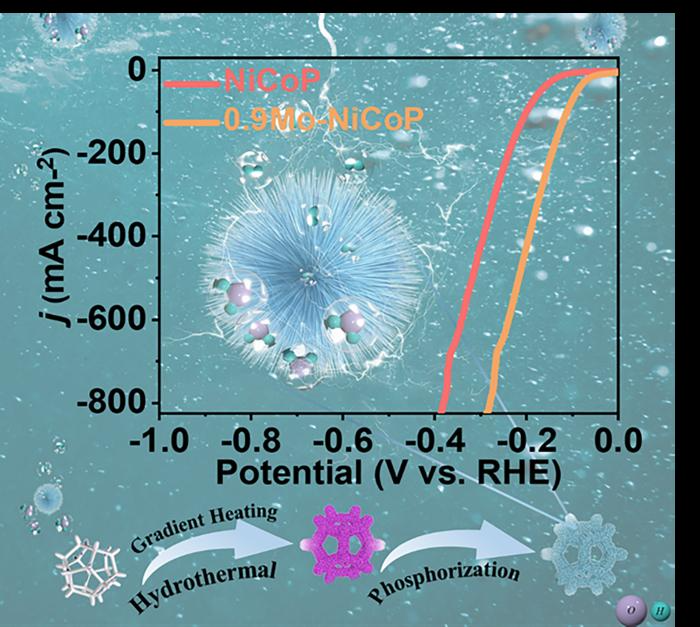The efficient, low-cost synthesis of hydrogen is a critical step in the creation of new, sustainable energy sources. A practical method for creating hydrogen is electrochemical water splitting, which uses an electrocatalyst to separate water into its hydrogen and oxygen elements. Catalysts are usually constructed on costly elements like platinum, which makes it challenging to implement this technology on a wider commercial level.
This diagram shows the nanoneedle structure of the electrocatalyst that is molybdenum-doped nickel-cobalt phosphide. The graph demonstrates the polarization curve, which demonstrates the improvement in the electrocatalyst when molybdenum is added to it. The graphic on the bottom also illustrates the gradient heating hydrothermal process to produce the electrocatalyst. Image Credit: Nano Research, Tsinghua University Press
In a recently released study, researchers showed how the addition of molybdenum to a nickel-cobalt phosphide catalyst and its synthesis using a gradient hydrothermal process, in which the catalyst is heated to 100 degrees, 150 degrees, and then 180 degrees Celsius over 10 hours, increased the catalyst’s performance and led to hydrogen production that could be more suitable for large-scale hydrogen production.
On July 26th, 2023, the research was published in Nano Research.
The innovative combination of gradient hydrothermal and phosphidation processes forms a microsphere structure. These nanoparticles with a diameter of approximately 5 to 10 nanometers form nanoneedles, which subsequently self-assemble into a spherical structure. The nanoneedles offer abundant active sites for efficient electron transfer and the presence of small-sized particles and micro-scale roughness enhances the release of hydrogen bubbles.
Yufeng Zhao, Professor, College of Sciences and Institute for Sustainable Energy, Shanghai University
A method known as element doping was used by the researchers to produce this particular microstructure. The deliberate addition of impurities to a catalyst to increase its activity is known as element doping. In this study, bimetallic nickel-cobalt phosphide (P) with molybdenum (Mo) was introduced.
The cobalt and nickel ions combine to provide the excellent electrocatalytic activity of Ni-Co phosphides. Mo-doped Ni-CoP was added, and then it was applied to a nickel foam utilizing a gradient hydrothermal technique. Following this procedure, the phosphide developed a special microstructure made of nanoneedles.
Zhao added, “Trace molybdenum doping optimizes the electronic structure and increases the number of electroactive sites.”
The dependability, stability, and performance of the Mo-doped Ni-CoP catalyst were evaluated. After 100 hours, its density remained almost constant, and its structure was well-maintained, due in part to the unusual structure of the nanoneedles, which prevents the catalyst from collapsing as hydrogen builds. Calculations revealed that the phosphide catalyst was likewise extremely efficient.
In the future, researchers want to examine the reaction’s performance in diverse conditions, such as acidic and neutral solutions. Future research will also look into nickel foam alternatives, such as titanium mesh, which can work across a wide pH range.
“In future work, we recommend exploring the application of the catalyst in the oxidation-assisted hydrogen production of small molecules, such as urea. This approach would reduce the overpotential of water electrolysis and mitigate environmental pollution caused by urea wastewater,” Zhao further stated.
Chengyu Huang, Zhonghong Xia, Jing Zhang, Chenfei Zhao, Jiujun Zhang, and Shengjuan Huo of the College of Sciences & Institute for Sustainable Energy Shanghai University, Jing Wang at the State Key Laboratory of Metastable Materials at Yanshan University; Xingli Zou and Xionggang Lu at the State Key Laboratory of Advanced Special Steel & Shanghai Key Laboratory of Advanced Ferrometallurgy & School of Materials Science and Engineering at Shanghai University, Shichun Mu at the State Key Laboratory of Advanced Technology for Materials Synthesis and Processing at Wuhan University of Technology, and HongJin Fan at the School of Physical and Mathematical Sciences at Nanyang Technological University are the other contributors of the study.
This study was funded in part by the National Natural Science Foundation of China (22179077), the National Natural Science Foundation Youth Fund (22209104), the Shanghai Science and Technology Commission’s “2020 Science and Technology Innovation Action Plan” (20511104003), the Natural Science Foundation of Shanghai (21ZR1424200), the Hebei Provincial Department of Science and Technology (226Z4404G), and the Hebei Science Foundation (E2021203005).
Journal Reference
Huang, C., et al. (2023) Highly efficient and stable electrocatalyst for hydrogen evolution by molybdenum doped Ni-Co phosphide nanoneedles at high current density. Nano Research. doi:10.1007/s12274-023-5892-7


